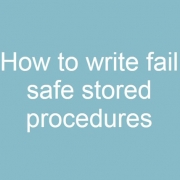How to write fail safe stored procedures
We normally write stored procedures for nearly any transaction that has more than one component to it. For example, creating an invoice record that has many lines would require you to insert a record into a header table, and multiple records into a detail table. But what happens if you insert the header and one of the detail records fails to get inserted properly. In these cases, you’re usually greeted by a SQL Exception and error out. However, depending on how you write your stored procedure, you might now have one header record and some of the detail records in the database. In some cases this might be okay, but in most cases it is not and the preference would be to avoid inserting any of the records if even one of them fails. Luckily MySQL provides a really great solution for this problem.
BEGIN
.. Declare statements ..
DECLARE EXIT HANDLER FOR SQLEXCEPTION
BEGIN
ROLLBACK;
END;
START TRANSACTION;
.. INSERT ..
.. UPDATE ..
.. SELECT ..
COMMIT;
END


